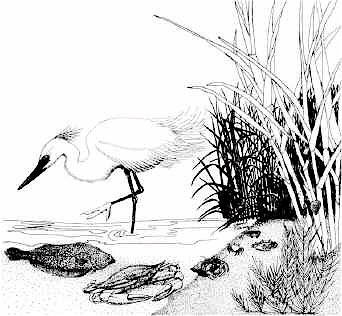DID YOU KNOW?
-
Three out of seven major estuaries in Texas are found within the Coastal Bend.
-
The Coastal Bend bays and estuaries provide a home to more than 3,200 known species of plants and animals.
-
Bays and estuaries of the Coastal Bend cover 515 square miles of water.
-
Almost half of the commercial finfish in Texas waters are harvested from the CCBNEP study area.
What is an Estuary?
The community of life found in these waters and associated wetlands include mammals, birds, fish, reptiles, shellfish, and plants - all interacting within complex food webs.

Estuaries have economic, recreational, and aesthetic value. People are attracted to the water and visit estuaries to boat, fish, swim and enjoy their beauty. As a result, the economies of many coastal communities depend on the natural beauty and bounty of their estuaries. In fact, almost 70 percent of the economy in the Coastal Bend can be directly or indirectly attributed to our bays and estuaries in some way.
Estuaries come in all shapes and sizes, each unique to their location and climate. Where there are estuaries, there is unique beauty. When viewing an estuary from the air the dramatic river bends, marsh grasses, and mudflats paint a unique mosaic scenery.
With all the physical forces at work in an estuary (the flow of rivers; the deposition of sediments; the ebb and flow of tides) conditions are constantly changing. Species that evolve in estuaries are therefore adapted to tremendous variability and extreme conditions in their environment.
Long considered to be wastelands, estuaries have had their sediments dredged, marshes and tidal flats filled, water polluted, and shorelines reconstructed to accommodate housing, transportation, commerce, industry, and agricultural needs.
As our population grows and the demands imposed on our natural resources increase, so too does the importance of protecting these resources for their natural and aesthetic values.
Nurseries: Many marine organisms, and most commercially valuable fish species, depend on estuaries at some point during their development.
Productivity: Within the sediments -- whether mud, silt, sand or rocks -- live billions of microscopic bacteria, a lower level of the food web that subsist largely on decaying plants. Nutrients are essential to a healthy aquatic ecosystem, but in excess can lead to algal blooms causing eutrophication, a condition which results in low dissolved oxygen.
Water Filtration: Water draining from uplands carries a load of sediments and nutrients. As the water flows through salt marsh peat and the dense mesh of marsh grass blades, much of the sediment and nutrient load is filtered out. This filtration process creates cleaner and clearer water.
Flood Control: Porous, resilient salt marsh soils and grass absorb flood waters and dissipate storm surges. Salt marsh dominated estuaries provide natural buffers between the land and the ocean. They protect upland organisms as well as billions of dollars of real estate that might otherwise be subjected to more intense natural forces.
Recognizing human threats and the natural value of estuaries, Congress created the National Estuary Program in 1987 as part of the Clean Water Act. The Corpus Christi Bay National Estuary Program (CCBNEP) was established in 1992. Its mission is to protect and restore the health of the three estuarine systems in the Coastal Bend while ensuring the sustainability of economic and recreational activities. These systems are: Aransas Estuary including Aransas and Copano Bays; Corpus Christi Estuary, including Corpus Christi and Nueces Bays; and the upper Laguna Madre, including Baffin Bay.
The CCBNEP is bringing Coastal Bend communities together to decide the future of their own bays and estuaries by combining the work of many groups including citizens, business leaders, government agencies educators, and researchers. The CCBNEP is investigating and developing management solutions for many areas of concern, including:
- BAY DEBRIS
- PUBLIC HEALTH ISSUES
- CONDITION OF LIVING RESOURCES
- ALTERED FRESHWATER INFLOW INTO BAYS AND ESTUARIES
- LOSS OF WETLANDS AND ESTUARINE HABITATS
- DEGRADATION OF WATER QUALITY
- ALTERED ESTUARINE CIRCULATION
The CCBNEP is identifying the estuary’s issues, recommending solutions and seeking implementation partnerships in a Coastal Bend Bays Plan. This Plan is a framework for revitalizing and protecting the estuary.
Talk to Elected Officials - Encourage government officials to recognize the values of estuaries, the need to protect these habitats, and maintain adequate freshwater inflow or well-placed treated wastewater returns.
Enjoy Wetlands - Plan a “walk in the wetlands” for your community or visit the Aransas National Wildlife Refuge to appreciate their beauty and values.
Participate in the Adopt-a-Wetland Program - This program is designed to get youth involved in wetland conservation by teaching scientific techniques for monitoring wetlands, providing data gathering experience in the field, and stimulating interest in science careers and academic programs. Call 512/980-3221 for more information.
Look into Government Programs - Contact state and federal environmental protection agencies to find out what laws, programs, and projects protect wetlands and estuaries.